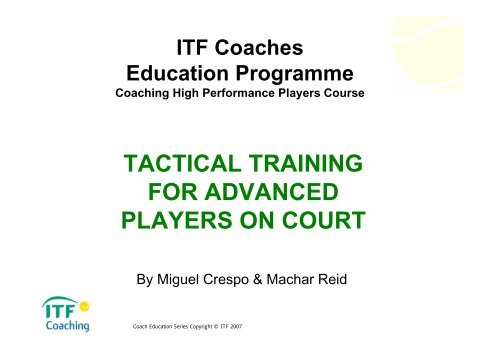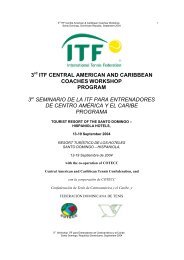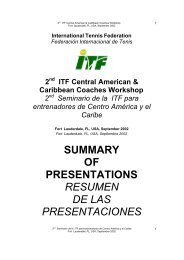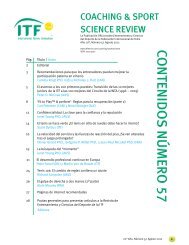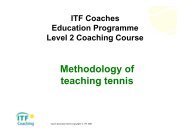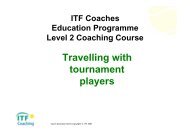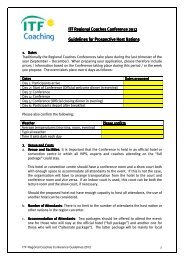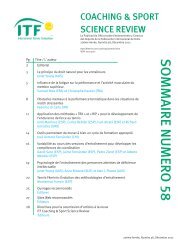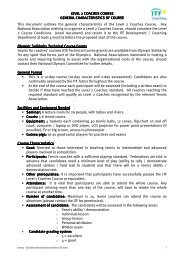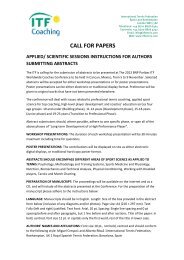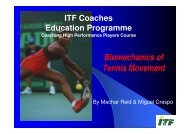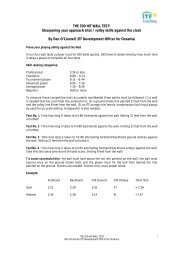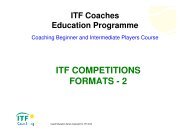tactical training for advanced players on court - Coaching - ITF
tactical training for advanced players on court - Coaching - ITF
tactical training for advanced players on court - Coaching - ITF
You also want an ePaper? Increase the reach of your titles
YUMPU automatically turns print PDFs into web optimized ePapers that Google loves.
<strong>ITF</strong> Coaches<br />
Educati<strong>on</strong> Programme<br />
<strong>Coaching</strong> High Per<str<strong>on</strong>g>for</str<strong>on</strong>g>mance Players Course<br />
TACTICAL TRAINING<br />
FOR ADVANCED<br />
PLAYERS ON COURT<br />
By Miguel Crespo & Machar Reid<br />
Coach Educati<strong>on</strong> Series Copyright © <strong>ITF</strong> 2007
By the end of this sessi<strong>on</strong> you<br />
should be able to:<br />
• Understand and practically apply the<br />
fundamentals of <str<strong>on</strong>g>tactical</str<strong>on</strong>g> <str<strong>on</strong>g>training</str<strong>on</strong>g> <str<strong>on</strong>g>for</str<strong>on</strong>g> <str<strong>on</strong>g>advanced</str<strong>on</strong>g><br />
<str<strong>on</strong>g>players</str<strong>on</strong>g> <strong>on</strong> <strong>court</strong>:<br />
• Theory<br />
• Practice<br />
• Periodisati<strong>on</strong><br />
• Practice matches<br />
•Drills<br />
Coach Educati<strong>on</strong> Series Copyright © <strong>ITF</strong> 2007
Coach Educati<strong>on</strong> Series Copyright © <strong>ITF</strong> 2007<br />
Introducti<strong>on</strong><br />
Teaching technique and tactics<br />
• At same time<br />
• Technical and <str<strong>on</strong>g>tactical</str<strong>on</strong>g> patterns<br />
• Basic <str<strong>on</strong>g>tactical</str<strong>on</strong>g> units of a tennis match<br />
• Fundamental of tactics in tennis<br />
• Helping our <str<strong>on</strong>g>players</str<strong>on</strong>g> how to play tennis (not<br />
how to produce the strokes)
Coach Educati<strong>on</strong> Series Copyright © <strong>ITF</strong> 2007<br />
Introducti<strong>on</strong><br />
Tactical patterns<br />
• Related to the game situati<strong>on</strong>s<br />
• Defined by <str<strong>on</strong>g>players</str<strong>on</strong>g> characteristics:<br />
– Technique<br />
– Physical c<strong>on</strong>diti<strong>on</strong><br />
– Mental abilities, etc.<br />
• They define the player gamestyle
General guidelines <str<strong>on</strong>g>for</str<strong>on</strong>g> tactics <str<strong>on</strong>g>training</str<strong>on</strong>g><br />
Coach Educati<strong>on</strong> Series Copyright © <strong>ITF</strong> 2007<br />
Theory<br />
• Explain theoretically the basics of tactics<br />
• Dem<strong>on</strong>strate <strong>on</strong> <strong>court</strong> when teaching<br />
beginners<br />
• Speak to your <str<strong>on</strong>g>players</str<strong>on</strong>g> about the importance<br />
of <str<strong>on</strong>g>tactical</str<strong>on</strong>g> <str<strong>on</strong>g>training</str<strong>on</strong>g> <str<strong>on</strong>g>for</str<strong>on</strong>g> tennis per<str<strong>on</strong>g>for</str<strong>on</strong>g>mance
General guidelines <str<strong>on</strong>g>for</str<strong>on</strong>g> tactics <str<strong>on</strong>g>training</str<strong>on</strong>g><br />
Coach Educati<strong>on</strong> Series Copyright © <strong>ITF</strong> 2007<br />
Training<br />
• Set realistic <str<strong>on</strong>g>training</str<strong>on</strong>g>, per<str<strong>on</strong>g>for</str<strong>on</strong>g>mance and<br />
outcome goals to achieve during <str<strong>on</strong>g>tactical</str<strong>on</strong>g><br />
<str<strong>on</strong>g>training</str<strong>on</strong>g>.<br />
• Try to have them properly motivated <str<strong>on</strong>g>for</str<strong>on</strong>g><br />
tactics <str<strong>on</strong>g>training</str<strong>on</strong>g> using realistic <str<strong>on</strong>g>training</str<strong>on</strong>g><br />
situati<strong>on</strong>s
General guidelines <str<strong>on</strong>g>for</str<strong>on</strong>g> tactics <str<strong>on</strong>g>training</str<strong>on</strong>g><br />
Coach Educati<strong>on</strong> Series Copyright © <strong>ITF</strong> 2007<br />
Training<br />
• Work <str<strong>on</strong>g>tactical</str<strong>on</strong>g> adaptati<strong>on</strong> and change through<br />
tennis drills<br />
• Make your <str<strong>on</strong>g>players</str<strong>on</strong>g> c<strong>on</strong>trol their emoti<strong>on</strong>s,<br />
thoughts and feelings with progressive<br />
relaxati<strong>on</strong> exercises and breathing routines<br />
• Applied them <strong>on</strong> <strong>court</strong> during practice<br />
sessi<strong>on</strong>s as part of their <str<strong>on</strong>g>tactical</str<strong>on</strong>g> <str<strong>on</strong>g>training</str<strong>on</strong>g>
General guidelines <str<strong>on</strong>g>for</str<strong>on</strong>g> tactics <str<strong>on</strong>g>training</str<strong>on</strong>g><br />
Matchplay<br />
• Allow <str<strong>on</strong>g>players</str<strong>on</strong>g> to explore their own <str<strong>on</strong>g>tactical</str<strong>on</strong>g><br />
knowledge when playing their first tennis<br />
matches<br />
• Try to prepare <str<strong>on</strong>g>tactical</str<strong>on</strong>g>ly the matches of your<br />
<str<strong>on</strong>g>players</str<strong>on</strong>g><br />
• Get them used to think <str<strong>on</strong>g>tactical</str<strong>on</strong>g>ly during the<br />
match (specially during the changeovers)<br />
Coach Educati<strong>on</strong> Series Copyright © <strong>ITF</strong> 2007
General guidelines <str<strong>on</strong>g>for</str<strong>on</strong>g> tactics <str<strong>on</strong>g>training</str<strong>on</strong>g><br />
Matchplay<br />
• Make them think and analyse the<br />
causes and c<strong>on</strong>sequences of the tactics<br />
they use in a match.<br />
• Define, practice and refine the <str<strong>on</strong>g>tactical</str<strong>on</strong>g><br />
scheme of each of your <str<strong>on</strong>g>players</str<strong>on</strong>g><br />
• Set specific and measurable goals<br />
(rankings, tournaments, etc.) <str<strong>on</strong>g>for</str<strong>on</strong>g> each<br />
match.<br />
Coach Educati<strong>on</strong> Series Copyright © <strong>ITF</strong> 2007
General guidelines <str<strong>on</strong>g>for</str<strong>on</strong>g> tactics <str<strong>on</strong>g>training</str<strong>on</strong>g><br />
Coach Educati<strong>on</strong> Series Copyright © <strong>ITF</strong> 2007<br />
Planning<br />
• Plan specific tactics <str<strong>on</strong>g>training</str<strong>on</strong>g> sessi<strong>on</strong>s.<br />
• Plan the tournament schedule<br />
according to your player gamestyle.<br />
• In the preparatory and the precompetiti<strong>on</strong><br />
periods combine the<br />
technical sessi<strong>on</strong>s with <str<strong>on</strong>g>tactical</str<strong>on</strong>g> <strong>on</strong>es.
General guidelines <str<strong>on</strong>g>for</str<strong>on</strong>g> tactics <str<strong>on</strong>g>training</str<strong>on</strong>g><br />
Coach Educati<strong>on</strong> Series Copyright © <strong>ITF</strong> 2007<br />
Planning<br />
• Try to make your tactics <str<strong>on</strong>g>training</str<strong>on</strong>g>s<br />
amusing but demanding (d<strong>on</strong>’t allow<br />
easy mistakes at the same time).<br />
• Test and evaluate your <str<strong>on</strong>g>players</str<strong>on</strong>g> tactics<br />
periodically (charting, computers, etc.).<br />
• Change your <str<strong>on</strong>g>tactical</str<strong>on</strong>g> <str<strong>on</strong>g>training</str<strong>on</strong>g> plan<br />
whenever necessary.
Specific guidelines <str<strong>on</strong>g>for</str<strong>on</strong>g> tactics <str<strong>on</strong>g>training</str<strong>on</strong>g><br />
Drills<br />
• Practice with match play situati<strong>on</strong>s: tiebreaks,<br />
etc.<br />
• Set specific scores: 1-4, 5-4-, 3-1, etc.<br />
• Speak with the <str<strong>on</strong>g>players</str<strong>on</strong>g> be<str<strong>on</strong>g>for</str<strong>on</strong>g>e each<br />
point or during changeovers.<br />
• Use different scores: volleyball, table.tennis,<br />
etc.<br />
Coach Educati<strong>on</strong> Series Copyright © <strong>ITF</strong> 2007
Specific guidelines <str<strong>on</strong>g>for</str<strong>on</strong>g> tactics <str<strong>on</strong>g>training</str<strong>on</strong>g><br />
Practice matches<br />
• Players should be of the same tennis<br />
level.<br />
• If not, adjust the level by stating some<br />
scoring rules.<br />
• Emphasise rest during changeovers.<br />
• Coach in some situati<strong>on</strong>s (make <str<strong>on</strong>g>players</str<strong>on</strong>g><br />
think).<br />
Coach Educati<strong>on</strong> Series Copyright © <strong>ITF</strong> 2007
Specific guidelines <str<strong>on</strong>g>for</str<strong>on</strong>g> tactics <str<strong>on</strong>g>training</str<strong>on</strong>g><br />
Practice matches<br />
• Practice doubles matches.<br />
• Make the <str<strong>on</strong>g>players</str<strong>on</strong>g> explain to you the match<br />
flow.<br />
• Set specific sessi<strong>on</strong>s <str<strong>on</strong>g>for</str<strong>on</strong>g> match practice (1.30<br />
- 2 hours.).<br />
• Practice full matches.<br />
• Do not allow Code of c<strong>on</strong>duct violati<strong>on</strong>s.<br />
• Apply tennis rules as if tournament situati<strong>on</strong>.<br />
Coach Educati<strong>on</strong> Series Copyright © <strong>ITF</strong> 2007
Specific guidelines <str<strong>on</strong>g>for</str<strong>on</strong>g> tactics <str<strong>on</strong>g>training</str<strong>on</strong>g><br />
Coach Educati<strong>on</strong> Series Copyright © <strong>ITF</strong> 2007<br />
Methodology<br />
• Use different teaching methods (global,<br />
analytic, sequence, progressive, etc.) to teach<br />
tactics depending <strong>on</strong> your students level of<br />
play.<br />
• Use different coaching styles (command,<br />
guided discovery, problem solving, etc) to<br />
teach tactics depending <strong>on</strong> the c<strong>on</strong>tents you<br />
are introducing
SPECIFIC GUIDELINES FOR tactics<br />
Coach Educati<strong>on</strong> Series Copyright © <strong>ITF</strong> 2007<br />
<str<strong>on</strong>g>training</str<strong>on</strong>g><br />
Methodology<br />
• Use different practice organisati<strong>on</strong>s (groups,<br />
pairs, "threes", etc.) to teach tactics<br />
depending <strong>on</strong> the degree of c<strong>on</strong>trol you want<br />
to have during <str<strong>on</strong>g>players</str<strong>on</strong>g> practice
Learning the game <strong>on</strong> clay:<br />
Coach Educati<strong>on</strong> Series Copyright © <strong>ITF</strong> 2007<br />
Pros & C<strong>on</strong>s<br />
• Growing up as a tennis player <strong>on</strong> a clay <strong>court</strong><br />
has several advantages:<br />
– Players develop a more c<strong>on</strong>sistent game<br />
– Groundstrokes are often very str<strong>on</strong>g<br />
– Learn to be patient<br />
– Develop good physical endurance.<br />
Cascales (2002)
Learning the game <strong>on</strong> clay:<br />
Coach Educati<strong>on</strong> Series Copyright © <strong>ITF</strong> 2007<br />
Pros & C<strong>on</strong>s<br />
• It does have its disadvantages:<br />
– Less focus is often placed <strong>on</strong> the development of<br />
their serve, return and net game<br />
– The l<strong>on</strong>gevity of the top clay <strong>court</strong>ers is typically<br />
shorter than the serve volleyers<br />
– It is too hard to sustain that intensity in l<strong>on</strong>g<br />
matches year after year<br />
Cascales (2002)
Drills to Rein<str<strong>on</strong>g>for</str<strong>on</strong>g>ce Making the Right<br />
Tactical Decisi<strong>on</strong>s<br />
Serve Management<br />
• Drill 1 – Serve Pressure<br />
– Play a set where the server is <strong>on</strong>ly allowed two sec<strong>on</strong>dserves<br />
per game.<br />
• Drill 2 – 7-11<br />
– Play to eleven points however the returner starts up 7-0.<br />
This drill could also be adjusted to 5-11. The server must<br />
serve and volley<br />
• Drill 3 – 10 points<br />
– Play a serving game where you count the number of first<br />
serves. Play a total of 10 points each game and keep track<br />
of your serving percentage. Play the point out after each<br />
first serve.<br />
Coach Educati<strong>on</strong> Series Copyright © <strong>ITF</strong> 2007<br />
Tiley (2002)
Drills to Rein<str<strong>on</strong>g>for</str<strong>on</strong>g>ce Making the Right<br />
• Drill 4 – Sequence<br />
Tactical Decisi<strong>on</strong>s<br />
Serve Management<br />
– Play points but in order <str<strong>on</strong>g>for</str<strong>on</strong>g> the point to count the serve,<br />
return and first volley must be in. Play to 11 and then switch<br />
serves.<br />
• Drill 5 – Side-out<br />
– Play to 11 points but you c<strong>on</strong>tinue serving until you lose the<br />
point. When you lose the point serving your opp<strong>on</strong>ent now<br />
becomes the server and that particular point does not<br />
count—you just lose the opportunity to serve.<br />
Coach Educati<strong>on</strong> Series Copyright © <strong>ITF</strong> 2007<br />
Tiley (2002)
Drills to Rein<str<strong>on</strong>g>for</str<strong>on</strong>g>ce Making the Right<br />
Tactical Decisi<strong>on</strong>s<br />
Return/Groundstroke C<strong>on</strong>sistency<br />
• Drill 6 – Grinder’s Paradise<br />
– Play to 11 points. First 6 balls have to be in <str<strong>on</strong>g>for</str<strong>on</strong>g> the point to start.<br />
Every ball has to be hit with topspin and with height over the net.<br />
You can adjust to reduce the target area to behind the service line.<br />
No serving.<br />
• Drill 7 – 5-5 Challenge<br />
– Both <str<strong>on</strong>g>players</str<strong>on</strong>g> start <strong>on</strong> the baseline. One player feeds the ball in and<br />
you play the point out. Both <str<strong>on</strong>g>players</str<strong>on</strong>g> start at 5 points and the goal is<br />
to reach 10 be<str<strong>on</strong>g>for</str<strong>on</strong>g>e 0. You lose a point <str<strong>on</strong>g>for</str<strong>on</strong>g> an un<str<strong>on</strong>g>for</str<strong>on</strong>g>ced error and<br />
win a point with a winner and when you <str<strong>on</strong>g>for</str<strong>on</strong>g>ce your opp<strong>on</strong>ent into an<br />
error.<br />
• Drill 8 – Forcing Special<br />
– Play to 21 points but you can <strong>on</strong>ly win a point with a winner or<br />
<str<strong>on</strong>g>for</str<strong>on</strong>g>ced error. Un<str<strong>on</strong>g>for</str<strong>on</strong>g>ced errors do not count. No serving.<br />
Coach Educati<strong>on</strong> Series Copyright © <strong>ITF</strong> 2007<br />
Tiley (2002)
Drills to Rein<str<strong>on</strong>g>for</str<strong>on</strong>g>ce Making the Right<br />
Tactical Decisi<strong>on</strong>s<br />
Return/Groundstroke C<strong>on</strong>sistency<br />
• Drill 9 – Scramble Singles<br />
– The entire singles and doubles <strong>court</strong> is c<strong>on</strong>sidered<br />
“in.” One player feeds a ball and you play the<br />
point out. Play to 11. No winners can be hit in the<br />
first game, however in the sec<strong>on</strong>d game to 11,<br />
winners count.<br />
• Drill 10 – Alley Rally<br />
– Both <str<strong>on</strong>g>players</str<strong>on</strong>g> stand facing each other in the alley.<br />
One player feeds a ball in and play the point out.<br />
Play to 11 but the ball has to land in the alley <str<strong>on</strong>g>for</str<strong>on</strong>g><br />
the point to count.<br />
Tiley (2002)<br />
Coach Educati<strong>on</strong> Series Copyright © <strong>ITF</strong> 2007


